Boffis
International Hazard
    
Posts: 1838
Registered: 1-5-2011
Member Is Offline
Mood: No Mood
|
|
Mono-nitration of dimethylaniline
Most references to the nitration of dimethylaniline are looking at the preparation of the explosive compound Tetryl which is not actually a simple
nitro-dimethylaniline but 2,4,6-trinitrophenyl-N-methylnitramine. There is very little published information on the preparation of mono- and
di-nitro-N,N-dimethylanilines in spite of their potential use in the dye manufacturing industry. In fact, most of the papers and patents dealing with
the preparation of these compounds originated from work carried out by the dye industry. My interest in these lower nitro derivatives is in the
preparation of 3,4-dinitro-N,N-dimethylaniline and its reduction to 4-(N,N-dimethylamino)-o-phenylenediamine, an interesting and sensitive reagent for
selenium 4+.
I managed to track down a couple of these papers, one by Romburgh2) and another by Groll1); in French and German respectively. The latter paper is
particularly interesting as it describes in some detail the mono-nitration of dimethylaniline to 3- and 4-nitro-dimethylanilines and the separation of
the isomers, a slightly modified version of Groll’s method is given by Noelting and Fourneaux 3) and another is available on Organic Synthesis4).
Several other papers in English describe the further nitration of the mono to di- and tri-nitro-dimethylaniline without the formation of a nitramine
and the concomitant loss of one methyl group (Romburgh 2); Swann 5); Hodgeson and Smith 6)).
The small-scale experiment described below was based on the original paper by Groll as I had not seen the Organic Synthesis paper. In Groll’s paper
he uses a large excess of sulphuric acid compared to the Organic synthesis and to what is actually required by the reaction. I used rather less
sulphuric acid than Groll in order to make the synthesis less wasteful and more cost-effective, though I still used more than the Org. Synth. Process.
The main purpose of the excess sulphuric acid seems to be as a heat-sink to help moderate the exothermic rection. In the Org. Synth. process they
recommend the addition of dry ice during the nitric addition. I used slow addition, cyclical cooling in the freezer and an external ice-bath to
control the temperature.
References
1) Groll; Berichte, 1886, p198-201; Ueber Metanitrodimethylanilin, Metanitrodiäthylanilin und deren Reductionsproducte.
2) Romburgh; Rec. Trav. Chem. 1887 p251-254 ; Sur quelques nitramines dérivant de diamines alkylées aromatiques.
3) Noelting & Fourneaux; Berichte; 1897; p2930-2948; Ueber die Reductionsproducte der nitrirten Dimethylaniline.
4) Org.Synth. Org. Synth. 1947, v27, p62 and Col. Vol. 3, p658. DOI: 10.15227/orgsyn.027.0062
5) H. Swann; A new modification of 3,4-dinitrodimethylaniline, JCS, 1920; pp1-4.
6) Hodgeson & Smith; The action of nitrous acid on 3 and 4-nitrodimethylaniline; JCS; 1931, pp1508-1510.
Experimental
5g of dimethylaniline were added to 30ml of concentrated sulphuric acid (96-98%); the mixture became warm but otherwise no obvious reaction occurred.
The nitrating mixture was prepared separately by mixing 2.8ml of 70% nitric acid with 8.6ml of concentrated sulphuric acid and about 10 milligrams of
urea added to ensure a low nitrous acid content and control nitrogen oxide formation.
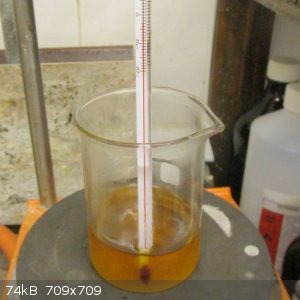
Fig. 1 chilled sulphuric acid-dimethylaniline mixture on the stirrer plate.
Both solutions were cooled in the freezer to about -14° C. When cold enough the beaker containing the dimethylaniline solution was equipped with a
thermometer place right to the bottom of the liquid, and a stir bar. The cold nitration mixture was added dropwise to the rapidly stirred
dimethylaniline solution. After the addition of about 2.5ml of the nitration mixture the temperature had risen to 0°C so addition was suspended and
the dimethylaniline solution returned to the freezer until its temperature was -12 to -14° again. After the addition of the nitration mixture was
suspended the temperature continued to rise and eventually reached 4°C, so it is important not to allow a build-up of excesses nitric acid in the
reaction solution. The remaining nitration mixture was also returned to the freezer.
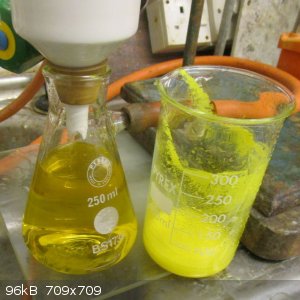
Fig. 2 filtering the diluted reaction mixture, note the bright yellow 4-isomer that separates.
When the temperature of both solutions has fallen below -12°C the addition was continued until the temperature reached 0°C and then the cycle
repeated until addition was complete. Four cycles were required to keep the temperature below 5°C. After addition was complete the mixture was
allowed to stand at room temperature (8-9°C) for 4.5 hours to complete the reaction.
The amber coloured homogeneous reaction mixture was then poured into 220ml of ice-cold water and then chilled to 4°C. The bright yellow p-nitro
isomer separated out as flocculent precipitate and was filtered off at the pump, washed with a little cold water and dried to give 1.467g of crude
p-isomer (21.4% of theory).
The filtrate was then partly neutralised until the precipitate of nitrodimethylaniline turned orange-red. Initially sodium carbonate (anhydrous) was
used but this caused too much frothing so 50ml of 50% NaOH solution was added and then only a little more sodium carbonate was required to reach the
point where the orange-red 3-isomer began to precipitate. The solution was chilled to 4°C and then filtered to recover the remaining less pure
p-isomer; the yield was an extra 0.192g or 2.8% of theory.
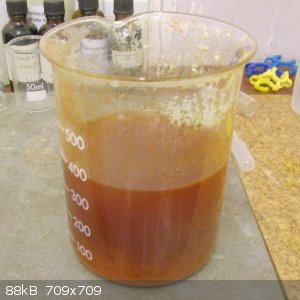
Fig. 3 the partly neutralised diluted liquor starting to ppt the red 3-isomer.
The filtrate was then neutralised by the addition of a further 50ml of 50% NaOH and then finally with anhydrous sodium carbonate. The hot suspension
proved hard to filter so was allowed to stand and cool for 3 hours when masses of colourless prisms of sodium sulphate also formed. The whole mass of
product and sodium salt was filtered (it now filtered easily) and dried. The mixture was partially dried by warming gently until most of it liquified
and then maintaining the temperature at about 40-50°C for 3 hours until only a little remaining liquid occurred in the red/white granular solid.
This partially dried cake was cooled, when it solidified, and then broken up and placed in a large beaker with 150ml of rectified spirit. The mixture
was slowly warmed almost to boiling over about an hour during which time the red material dissolved and the hard sodium sulphate broke down into a
sand-like material. The mixture was filtered hot and a further 50ml of rectified spirit used to rinse out the beaker and then wash the sandy sodium
sulphate.
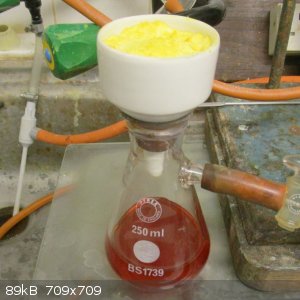
Fig. 4 filtering off the bright yellow sodium sulphate from the alcoholic extract.
The filtrate was allowed to cool overnight but only a little red 3-nitro isomer crystallised. The clear red liquid was decanted into a flask and
distilled to recover about 100ml of ethanol and the residue poured into a small beaker while still hot and allowed to cool, then chilled to 4°C. The
3-nitrodimethylaniline crystallised in beautiful red prisms. These were filtered off, washed with a little alcohol and dried to give 3.637g or 53.1%
of theory.
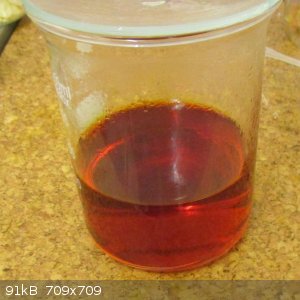
Fig. 5 the clear red alcohol leachate from the sodium sulphate cake.
The filtrate was distilled again to remove a further 55-60ml of alcohol and cooled. From this residue (circa 40-45ml) crystallised a further 0.338g
but it was a mixture of prisms of the orange-red 3-isomer and blocky, brick-red crystals of an unknown compound but probably a polynitro compound. On
almost complete evaporation only a dark red oil and a little water remained, these were discarded (note 1). The overall yield of recovered nitro-
compounds was therefore about 82%, assuming all are mono-nitro derivatives.
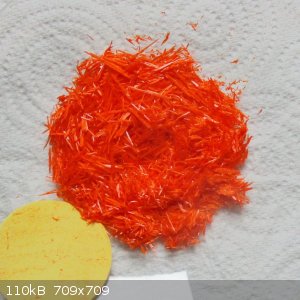
Fig. 6 the beautiful orange-red crystals of 3-nitro-dimethylaniline
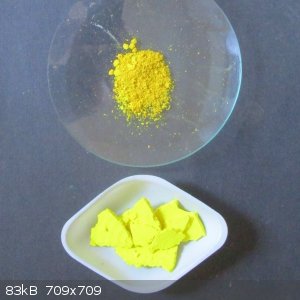
Fig. 7 the bright yellow 4-nitro isomer from the original precipitate (bottom) and that recovered from partial neutralisation (top).
The 0.338g of mixed crystals was roughly separated by hand-picking to give 0.146g of mainly orange-red prisms of the 3-nitro isomer and 0.176g
comprising mainly the unidentified brick-red blocky crystals.
The 0.146g were dissolved in 0.5ml of 95% ethanol with gentle heating to give a clear orange solution. On cooling bright orange-red prisms of the
3-nitro- isomer formed. These were filtered off, washed with a little diluted ethanol (c 65% alcohol) and dried to give 0.103g of clean
3-nitro-dimethylaniline.
The 0.176g of brick-red, blocky crystals were also dissolved in 0.5ml of 95% ethanol on warming to give a clear red solution but on slight cooling it
became cloudy so a further 0.5ml of alcohol were added and the mixture re-heated. On cooling slowly, surprisingly, only orange-red prisms of the
3-nitro isomer were deposited. These were filtered off, washed with a little diluted alcohol and dried to give a further 0.099g of
3-nitro-dimethylaniline. The filtrate was allowed to evaporate slowly but the residue was heavily contaminated with a dark red-brown oil and was
discarded.
Note 1; according to Noelting and Fourneaux steam distillation of the nitration mixture gives a small yield of the liquid 2-nitro isomer and it may be
that this oil is rich in this isomer.
Comment: The reaction is very exothermic and since temperature control is important to minimise poly-nitration scale-up of this reaction becomes more
difficult as the volume increases. Groll partially avoided this problem by using a vast excess of sulphuric acid which acts as a heat sink but this is
an expensive way around the problem. In the Org. Synth. method they recommends the addition of dry ice directly to the nitration mixture and if dry
ice is available this may be the best procedure. For laboratory scale preparations of 5-10g I have found that an ice-salt bath and slow addition are
sufficient, if somewhat tedious.
|
|
|
Pumukli
National Hazard
   
Posts: 686
Registered: 2-3-2014
Location: EU
Member Is Offline
Mood: No Mood
|
|
Very good hands-on (wet?) chemistry!
I really liked it, especially because I came across this synthesis in OrgSynth just a few days ago and now I could see it on "Technicolor" pictures as
well. 
Not much can be told I think. You made it and made it nicely - as usual.
|
|
|
Dr.Bob
International Hazard
    
Posts: 2666
Registered: 26-1-2011
Location: USA - NC
Member Is Offline
Mood: No Mood
|
|
Those are really pretty nitro compounds. That is a great separation of isomers based on crystallization, rarely see one work that well. In all of
my years of chemistry, I have not ever done a real nitration(at least that I remember), so I am almost jealous of your reaction.
|
|
|
Fery
National Hazard
   
Posts: 990
Registered: 27-8-2019
Location: Czechoslovakia
Member Is Offline
|
|
Hi Boffis, well done, you did great experiment and described everything into details!!! Very good yield, nice crystals and beautiful colors! Do you
have any planes with the product? Is nitration your favorite reaction? As you recently published nitration of benzotriazole...
|
|
|
Pumukli
National Hazard
   
Posts: 686
Registered: 2-3-2014
Location: EU
Member Is Offline
Mood: No Mood
|
|
"Not much can be told" ... 
Though on second thought, maybe a melting point or two is missing. 
I bet you have some TLC sheets as well, I would be curious how a run of these isomers side by side on a plate would look like! Would their intrinsic
colour enough for visualisation or a developer would be needed (besides the fluorescence of the plates if they have it).
|
|
|
Boffis
International Hazard
    
Posts: 1838
Registered: 1-5-2011
Member Is Offline
Mood: No Mood
|
|
Hi Guys, In this case because I was working with a well described procedure, both Groll's and the Org. Synth. one, I didn't run any TLC or Mp
measurements. My SM10 Mp equipment died about a year ago and I haven't replaced or repaired it yet.
As I explained in my introduction, my target is 4-(dimethylamino)-1,2-phenylenediamine, a sensitive reagent for selenium. Most aromatic o-diamines can
be used for this test but the reaction products are yellow. Two o-diamines however, give deep red and blue compounds. These are the above mentioned
compound and 4-methylthio-1,2-phenylenediamine. I can't just remember which gives the red and which the blue compound of the top of my head.
I intend to run this reaction at a larger scale using the Org. Synth. dry ice procedure later in the year when it cools down.
|
|
|
Fery
National Hazard
   
Posts: 990
Registered: 27-8-2019
Location: Czechoslovakia
Member Is Offline
|
|
Hi Boffis, interesting project. Here I found info about selenium complexes with diamines and blue with pyrrole:
https://www.ncbi.nlm.nih.gov/books/NBK216732/
| Quote: | | The most sensitive methods of detecting selenium involve the formation of piazselenols with orthodiamines (2,3-diaminonaphthalene; 3,3
′-diaminobenzidine; 1,8-naphthalenediamine; 4-dimethyl-1,2-phenylenediamine; 4-methylthio-1,2-phenylenediamine). In the presence of these reagents
in weakly acid solutions, selenites form piazselenols, which take on a straw-yellow color or, at higher levels of selenium, form brown-red
precipitates. After extraction into organic solvent (e.g., cyclohexane, dioxane, toluene, benzene), piazselenols fluoresce upon irradiation with
ultraviolet light. |
and there in table 2
https://www.ncbi.nlm.nih.gov/books/NBK216732/table/ttt00002/...
| Quote: | Reagent: Pyrrole
Se Detected: Se+4
Result of Reaction: pyrrole blue color
Detection Limit (µg/ml): 0.5 |
|
|
|
|